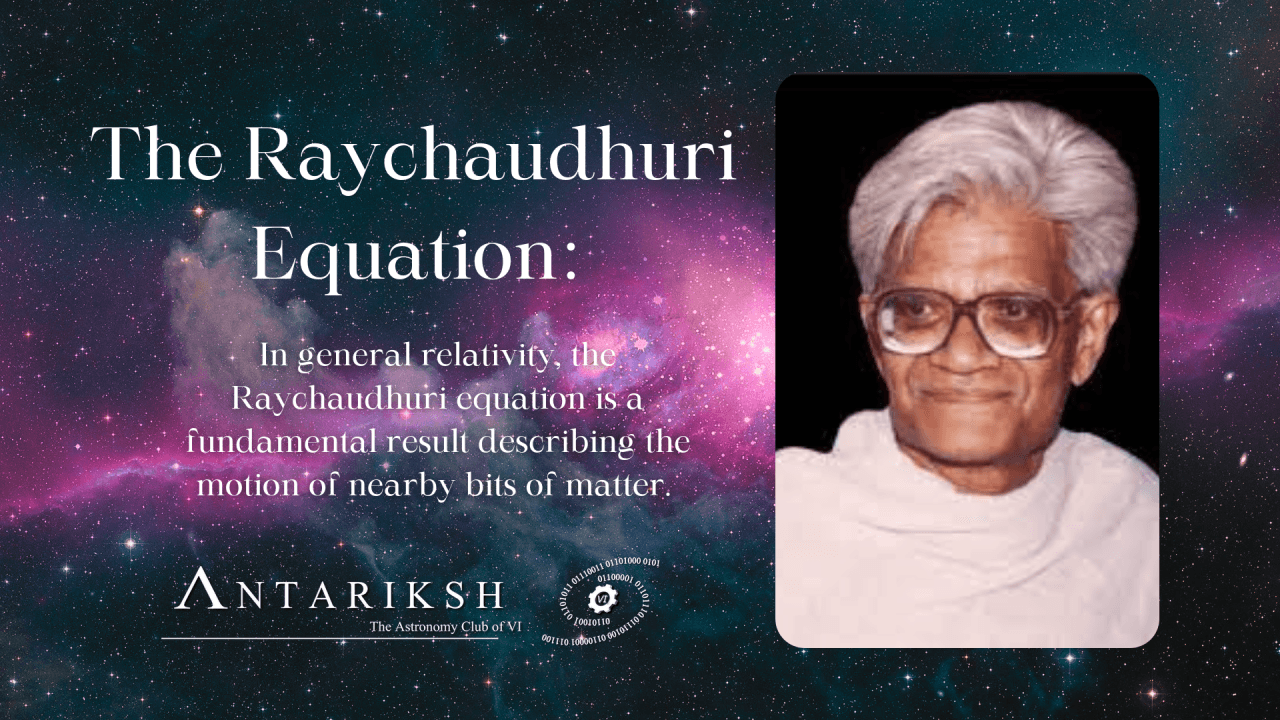
The DARKS
This paper explores the fundamental concepts of matter, antimatter, dark matter, and dark energy, which together form the building blocks of the universe. Matter, composed of baryonic particles, contrasts with antimatter, which annihilates matter upon contact. Dark matter, though invisible, exerts gravitational influence, while dark energy drives the universe's accelerating expansion. These concepts are critical to understanding the universe's composition, with dark energy constituting 68%, dark matter 27%, and observable matter less than 5%. Key historical discoveries are discussed to highlight the importance of ongoing research in cosmology.
| Published on 04 Nov 2023

Demystifying the "Raychaudhuri Equation"
The Raychaudhuri Equation is a cornerstone of general relativity, offering profound insights into the dynamics of spacetime, particularly in relation to singularities, gravitational collapse, and cosmology. Developed independently by Amal Kumar Raychaudhuri and Lev Landau, the equation examines how a collection of trajectories, or congruences, behaves in curved spacetime, providing critical contributions to our understanding of singularity theorems, black holes, and the expansion of the universe. Its applications extend beyond general relativity, influencing fields such as astrophysics, cosmology, and even quantum gravity research.
| Published on 05 Oct 2023

Jaipur's Jantar Mantar: Unveiling the Scientific and Architectural Marvel
The Jantar Mantar in Jaipur, built by Maharaja Sawai Jai Singh II in 1734, is a UNESCO World Heritage Site and an exemplary astronomical observatory. Its 19 intricately designed stone instruments reflect the advanced knowledge of ancient Indian astronomers, used to measure celestial positions and time with remarkable accuracy. Instruments such as the Vrihat Smarat Yantra and Jaya Prakash Yantra showcase precise engineering and scientific understanding. This paper explores the historical, scientific, and architectural significance of Jantar Mantar, emphasizing its enduring contribution to astronomical studies.
| Published on 07 Sep 2023

Unveiling the Humming Universe: India's Contribution to Gravitational Wave Discovery
India's contribution to the discovery of ultra-low frequency gravitational waves marks a significant breakthrough in astrophysics. The collaboration between Indian, Japanese, and European astronomers, utilizing India's upgraded Giant Metrewave Radio Telescope (uGMRT), has unveiled the "humming" of the universe caused by supermassive black hole pairs. This achievement underscores the importance of global scientific partnerships. The Indian Pulsar Timing Array (InPTA), part of this effort, played a key role in capturing precise pulsar signals, paving the way for future exploration of cosmic mysteries.
| Published on 17 Aug 2023

ISRO's PSLV-C56 Mission: A Triumph of Collaboration and Excellence
The successful launch of ISRO's PSLV-C56 mission highlights India's growing capabilities in space exploration. The mission placed Singapore's DS-SAR satellite and six co-passenger satellites into orbit, demonstrating technical precision and international collaboration. This achievement strengthens India-Singapore relations and showcases ISRO's commitment to sustainable space practices, as evidenced by the PS4 de-orbiting experiment. The mission underscores the importance of global partnerships in advancing satellite technology, fostering innovation, and ensuring responsible use of space resources.
| Published on 03 Aug 2023

2- UV, Optical, IR Astronomy
This lecture explores the mechanics of tracking celestial objects with telescopes, emphasizing the impact of Earth's rotation and the complex adjustments required to maintain focus. Using an Altazimuth mount, telescopes like the Gemini (with its 8-meter mirror) face engineering challenges related to weight, stability, and alignment, especially in mountain environments with wind and temperature variations. Additionally, atmospheric turbulence impacts observation quality, causing a phenomenon known as "atmospheric seeing," where turbulent air distorts light, degrading image clarity. Advances in technology continue to improve telescope designs, allowing more precise astronomical observations despite environmental challenges.
| Published on 30 Jul 2023